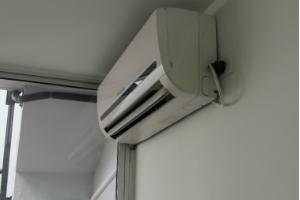 In recent years, minisplit systems have evolved in terms of the type of refrigerant used or the Seasonal Energy Efficiency Index (SEER), two key references for a good selection of equipment. by Duván Chaverra Agudelo
In recent years, minisplit systems have evolved in terms of the type of refrigerant used or the Seasonal Energy Efficiency Index (SEER), two key references for a good selection of equipment. by Duván Chaverra Agudelo
There is no doubt that the residential sector is the one that contributes the most to the commercialization of minisplit systems, for reasons such as its comfort, design, features and price. For that reason it is always important to know how much this market evolves in terms of market and technology, this last point being the main reference of this article. Perhaps the advances in this class of systems are not very significant year after year in their operation and mission, however, companies work every day to design equipment that meets the needs of their customers in terms of performance, and that also includes the issue of energy saving. Two leading companies in the air conditioning systems industry, in this case minisplit systems, will share their concepts on the technological advances of this technology: Bengie Seda is the sales manager of residential and light commercial equipment at Carrier, while Rafael Rojo is the director of the Mexico area of Lennox Industries. Initially, both professionals agreed that the main technological advances of minisplits systems have to do with the search for energy efficiency. Bengie commented that "minisplit systems with inverter technology are currently the newest on the market, these have outdoor units of a light and compact design that work efficiently and quietly." And it is that the inverter technology allows to regulate the mechanism of the air conditioning and keep constant the temperature of the air to be heated. Because it consumes only the necessary energy, it manages to reduce noise and consumption, which is proportional to its implementation. Another important point in terms of technological progress and selection of a team has to do with the reference of the SEER (Seasonal Energy Efficiency Index), which has been growing year after year, as indicated by Rafael Rojo: "Recently there has been an increase in the efficiency levels of the minisplits equipment. Some models are approaching or already far surpassing the SEER23." Bengie considers that the SEER is a reference to keep in mind when acquiring a minisplit system. "It is an option that the customer will look for based on costs for energy savings according to their country. The fastest moving SEER on the market is between 10 for regular products and 16 for inverter models. The largest SEER for minisplit currently found is up to 23 SEER with inverter system." There is also the reference EER (Degree of Electricity Efficiency), which is taken into account for the air conditioning of the rooms. Rafael stressed that the measurement from the EER or SEER has different appreciations according to the country and that currently the industry is working so that these indicators increase in their number in order to improve efficiency levels. "Currently the market is dominated by a demand for low-cost units where efficiency in most cases is below 9.2 EER. Some countries have slightly raised these required minimum efficiency levels. For example, to comply with the existing standards in Mexico, minisplit systems need to exceed a minimum efficiency of 9.3 EER (2.72 EER W/W), Venezuela requires compliance with the 10 SEER and countries such as Ecuador are working to establish this type of standards. It goes without saying that in the United States a minimum efficiency of 13 SEER is required. The Lennox representative adds that cost is still the main purchasing pattern: "There is currently a fairly large range of efficiencies available in the market. From very low efficiency units (from 8 to 9 EER) to "inverter" type systems with efficiencies of up to 27 SEER in some cases. Unfortunately the level of efficiency is not the determining factor in most cases, on the contrary the initial cost of the unit is."
The R410a makes its way
Our guests agree that the use of R22 refrigerant continues to dominate the market for minisplit systems, however, the current and future outlook is encouraging in terms of the interest of companies in modifying refrigerants, in order to contribute to the care of the ozone layer. "Basic energy equipment is still available with R-22 refrigerant, but every day the number of more efficient options on the market is growing using R410a refrigerant, which does not damage the ozone layer. R-22 is decreasing in use but there are still certain countries such as Venezuela and Peru that import them. In any case, the acceptance of the option with R-410a continues to increase and there are segments such as the light commercial that was changed almost entirely to this option, "said Bengie Seda. Rafael Rojo assures that the tendency is for the market step by step to walk towards the use of R410a, but recognizes that R22 continues to lead in implementation. "Although R22 still dominates the market as the most used refrigerant in minisplit systems, there is beginning to be a growing demand for units with ecological refrigerant, especially in projects of a certain level for multinational or government companies where already internal regulations begin to demand more efficient units and less harmful to the environment. There are a few options in basic efficiency units with eco-friendly refrigerant, R410A is mostly used in high-efficiency minisplit systems and inverters (13 SEER or higher)." Bengie adds in this regard that in addition to the refrigerants mentioned there is another option. "R-410a will be used in the coming years, but, since it is not the best option for global warming, it is expected that the refrigerant HFO-R1234yf, which is already being used in car air conditioners replacing R-134 and offering only a level 4 damage to the ozone layer, will become an option for the future." Marketing
The Carrier representative estimates that minisplit systems in Latin America are used in 65% of air conditioning applications, especially in the residential industry, partly due to high energy costs in some countries in the region and consumption limitations in others. Rafael Rojo, on the other hand, agrees with the previous assessment by recognizing a constant increase in the demand for this class of systems. But it also recognizes that sometimes these units are not used in the right applications, such as in places where more than five people are located, as we referenced earlier in our article "What if I use minisplit in my company?" (Installation of AC in commercial environments – Print edition November/December 2011). "The main reasons are the relatively low costs compared to other available options, in addition to the ease of installation. Minisplit units do represent a very adaptable option to applications, but, although they are mainly focused on the residential market due to their low cost, these types of units tend to be overused in applications that are not ideal or for which they are not the best alternative. "













